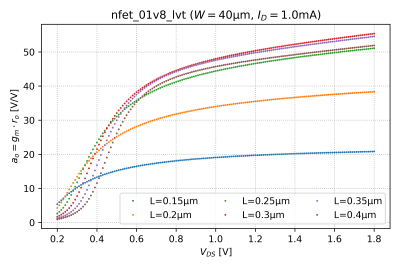Design: A Simple Common-Source Amplifier: Difference between revisions
No edit summary |
|||
| Line 18: | Line 18: | ||
* Repeat for transistor lengths of <math>0.20\mathrm{\mu m}</math>, <math>0.25\mathrm{\mu m}</math>, <math>0.30\mathrm{\mu m}</math>, <math>0.35\mathrm{\mu m}</math>, and <math>0.40\mathrm{\mu m}</math>, and generate the graphs in Fig. 2. | * Repeat for transistor lengths of <math>0.20\mathrm{\mu m}</math>, <math>0.25\mathrm{\mu m}</math>, <math>0.30\mathrm{\mu m}</math>, <math>0.35\mathrm{\mu m}</math>, and <math>0.40\mathrm{\mu m}</math>, and generate the graphs in Fig. 2. | ||
You can use a voltage-controlled voltage source (VCVS) to model the ideal amplifier. | You can use a voltage-controlled voltage source (VCVS) to model the ideal amplifier. Aside from obtaining the intrinsic gain at different lengths, we can use this circuit as a replica bias generator, to generate the DC input voltage of a common-source amplifier using the same transistor, as shown in Fig. 3. | ||
== Design: A Common-Source Amplifier == | == Design: A Common-Source Amplifier == | ||
Now that we have obtained the transistor (1) large-signal characteristics, i.e. the transfer and output characteristics, and (2) the small-signal parameters, <math>g_m</math>, <math>r_o</math>, <math>f_T</math>, and <math>a_0</math>, we can now use these characteristics to design a simple common-source amplifier biased with an ideal current source. | |||
{| | {| | ||
| [[File:Cs-amp-gain-sim-setup.png|thumb|500px|Figure 3: A simple NMOS common-source amplifier.]] | | [[File:Cs-amp-gain-sim-setup.png|thumb|500px|Figure 3: A simple NMOS common-source amplifier.]] | ||
Revision as of 06:59, 13 October 2022
- Instructions: This activity is structured as a tutorial with an activity at the end. Should you have any questions, clarifications, or issues, please contact your instructor as soon as possible.
- At the end of this activity, the student should be able to:
- Design a simple common-source amplifier.
Activity 1: Transistor Intrinsic Gain
We can determine the intrinsic NMOS small-signal gain, , for a desired DC operating point, i.e for a given drain current, , and drain-to-source voltage, . This implies a certain gate-to-source voltage, . For square-law devices, we can easily calculate the required that corresponds to and . However, for deep submicron devices that do not follow the square law, we can either run simulations to determine this , or instead, we can let SPICE calculate for us. As seen in Fig. 1, we can use negative feedback to obtain the appropriate .
Using the circuit in Fig. 1, with , , , and the ideal amplifier gain, :
- Sweep from 200mV to 1.8V, and plot as a function of .
- From the vs. plot, derive the NMOS instrinsic gain, , as a function of .
- Repeat for transistor lengths of , , , , and , and generate the graphs in Fig. 2.
You can use a voltage-controlled voltage source (VCVS) to model the ideal amplifier. Aside from obtaining the intrinsic gain at different lengths, we can use this circuit as a replica bias generator, to generate the DC input voltage of a common-source amplifier using the same transistor, as shown in Fig. 3.
Design: A Common-Source Amplifier
Now that we have obtained the transistor (1) large-signal characteristics, i.e. the transfer and output characteristics, and (2) the small-signal parameters, , , , and , we can now use these characteristics to design a simple common-source amplifier biased with an ideal current source.
Report Guide
Write up a report (maximum of 5 pages including figures) answering the questions above. Include annotated graphs if needed.
Submission
This activity is for both graduate and undergraduate students. For UP students, the submission bin link will be posted in Piazza.




















